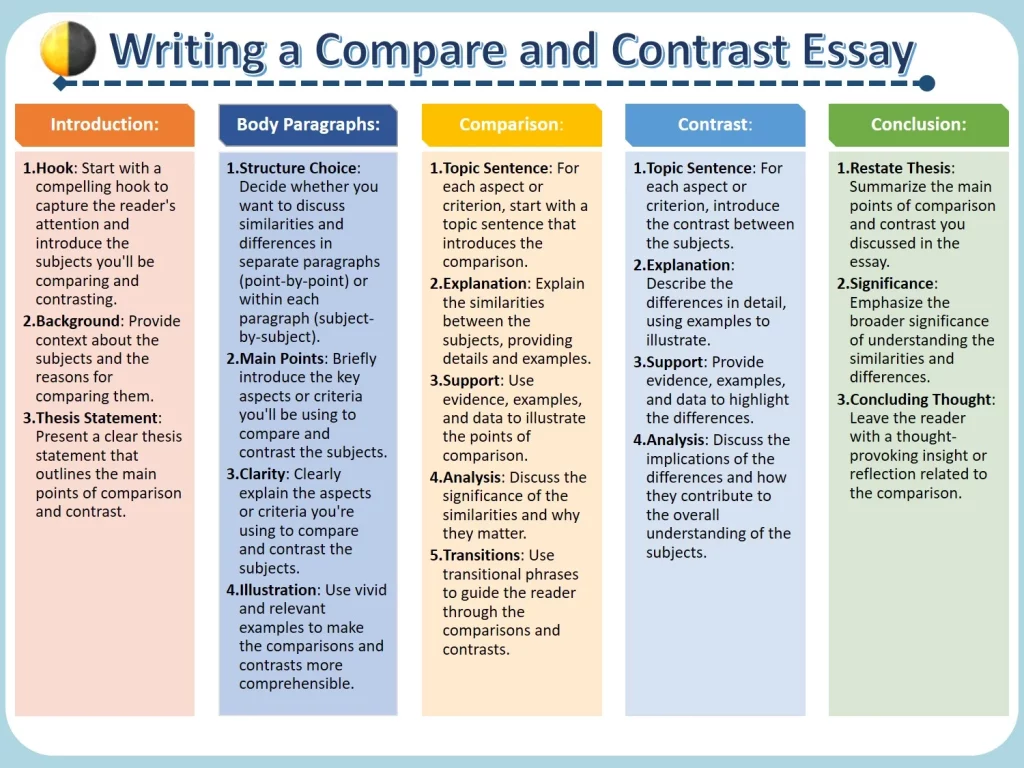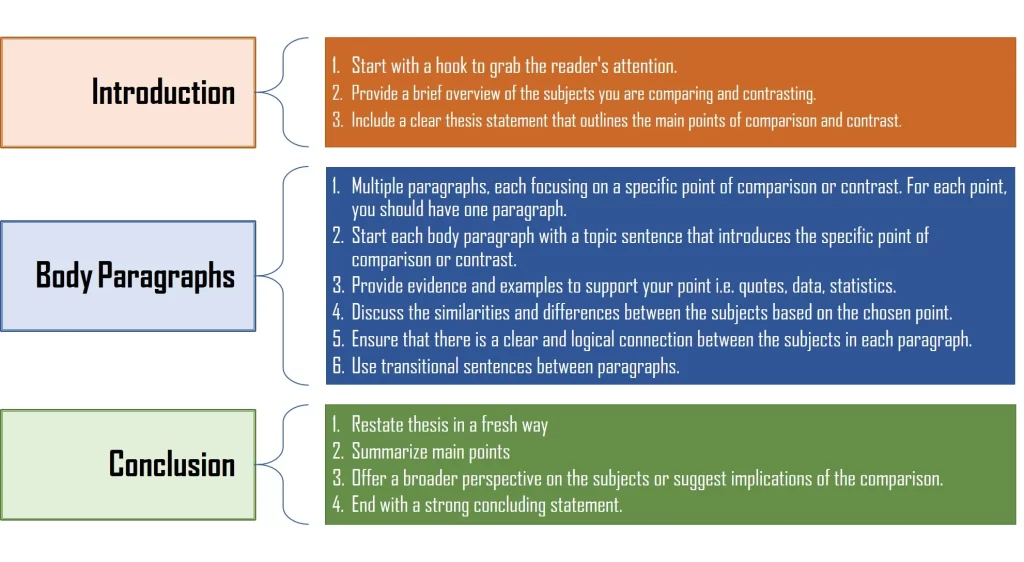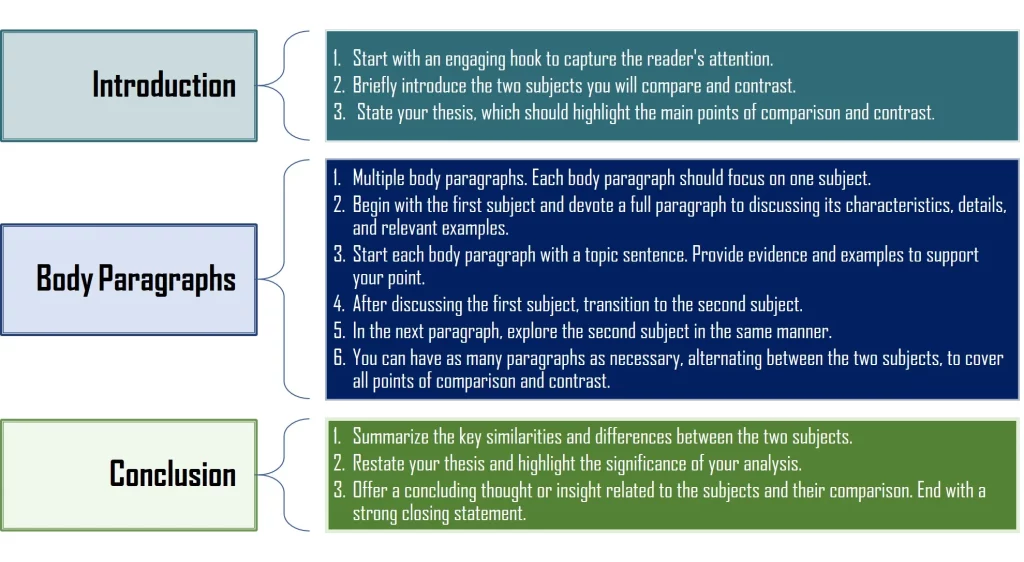
A compare and contrast essay is a type of academic writing that involves analyzing two or more subjects (usually two) to identify their similarities and differences. This type of essay aims to provide a deeper understanding of the topics being compared by highlighting both their commonalities and distinctions.
Key Elements
- Introduction: The introduction sets the stage for your essay by providing background information on the subjects you are comparing and contrasting. It also includes a clear thesis statement that outlines the main points of your comparison.
- Body paragraphs: The body of the essay is where you present your comparisons and contrasts. Each paragraph typically focuses on one aspect or point of comparison. You can organize your essay in two main ways:
- Evidence and examples: Support your comparisons and contrasts with relevant evidence and examples. This could include quotes, statistics, anecdotes, or other forms of evidence that strengthen your arguments.
- Transitions: To ensure a smooth flow between paragraphs and ideas, use transitional words and phrases (e.g., “similarly,” “on the other hand,” “in contrast,” “likewise”) to guide your readers through your comparisons and contrasts.
- Conclusion: Summarize the main points of your comparison and contrast in the conclusion. Restate your thesis and offer some insights or final thoughts on the significance of the comparisons you’ve made.
Compare and contrast essays are commonly assigned in academic settings because they require critical thinking skills and the ability to analyze and synthesize information. They are used to explore relationships between different subjects, make informed judgments, and communicate your insights effectively to the reader.
Point-by-Point Format

The point-by-point format is a common and effective way to structure a compare and contrast essay. In this format, you discuss specific points of comparison or contrast between the two subjects in each paragraph.
Sample Point-by-Point Compare and Contrast Essay: Online vs Traditional Education
Here’s a step-by-step guide on how to write a compare and contrast essay using the point-by-point format:
- Introduction:
- Body Paragraphs (Multiple Paragraphs):
- Conclusion:
- Citations:
Block Method

The block method, also known as the whole-to-whole method, is another effective way to structure a compare and contrast essay. In this format, you discuss each subject (A and B) in separate blocks of text before drawing overall conclusions in the conclusion section.
Sample Block Method Compare and Contrast Essay: City vs. Rural Life
Here’s a step-by-step guide on how to write a compare and contrast essay using the block method:
- Introduction:
- Body Paragraphs (Multiple Paragraphs):
- Conclusion:
- Citations:
Types
- Comparison (Only) Essay:
- Contrasting (Only) Essay:
- Combined (Compare and Contrast) Essay:
- Comparative Analysis Essay:
In a combined essay, it’s crucial to maintain a clear organizational structure and ensure that your comparisons and contrasts are presented logically and coherently. This type of essay is often considered more versatile because it enables you to explore various aspects of the subjects in a well-rounded manner, offering a deeper understanding to your readers.
How to Write: Steps
- Choose Your Subjects:
- Brainstorm and Organize Ideas:
- Create a Thesis Statement:
- Develop an Outline:
- Write the Introduction:
- Write the Body Paragraphs:
- Write the Conclusion:
- Revise and Proofread:
- Get Feedback: Have someone else read your essay to provide feedback and catch any errors you may have missed.
- Finalize Your Essay:
Remember that a successful compare and contrast essay not only points out similarities and differences but also provides insight into why those similarities and differences matter. It should engage the reader and help them understand the significance of the comparison.
Writing Tips: Dos & Don’ts
- Establish a Clear Criteria; Don’t Leave it Undefined!
- Craft a Clear, Focused and Concise Thesis Statement; Don’t Be Vague!
- Organize Your Essay Logically, Don’t Jumble Up!
- Provide Strong Evidence and Examples; Don’t Make Unsupported Claims!
- Use Transition Words Effectively; Don’t Rely on Topic Sentences Only!
- Stay Focused on the Main Points; Don’t Go Off-Topic!
- Analyze Significance and Implications; Don’t End Your Essay Abruptly!
- Revise and Proofread Carefully; Don’t Submit a Poorly Written Essay!
Frequently Asked Questions (F.A.Qs)
-
How do I choose a good topic for my compare and contrast essay?
-
What is the purpose of writing a compare and contrast essay?
-
How do I develop a strong thesis statement for my essay?
-
What are some effective techniques for comparing and contrasting two subjects?
-
How can I ensure that my compare and contrast essay is well-organized and coherent?
-
How do I cite sources and provide references in a compare and contrast essay?
-
What resources or tools can help me improve my compare and contrast essay writing skills?
-
How long should a typical compare and contrast essay be?
Length varies, but it’s often around 500 to 1500 words, depending on the complexity of the topic and assignment requirements.
-
How can I make my compare and contrast essay stand out and be engaging for the reader?
-
What is the difference between a compare and contrast essay and other types of essays, like argumentative or descriptive essays?
-
Should I focus more on the similarities or differences in my essay?
The balance depends on your purpose and topic. Some essays emphasize one over the other, while others provide a balanced perspective.
-
Can I use first-person pronouns in a compare and contrast essay?
It depends on your instructor’s guidelines. Some may allow first-person pronouns (I, we), while others prefer a more formal, third-person approach.
-
How can I revise and proofread my compare and contrast essay effectively before submitting it?
Remember, the key to writing a successful compare and contrast essay is to carefully select meaningful topics, develop a clear thesis statement, provide evidence and examples, maintain a well-organized structure, and engage the reader by highlighting both the significance of similarities and differences. Additionally, thorough revision and proofreading are essential to ensure clarity and coherence in your writing.
